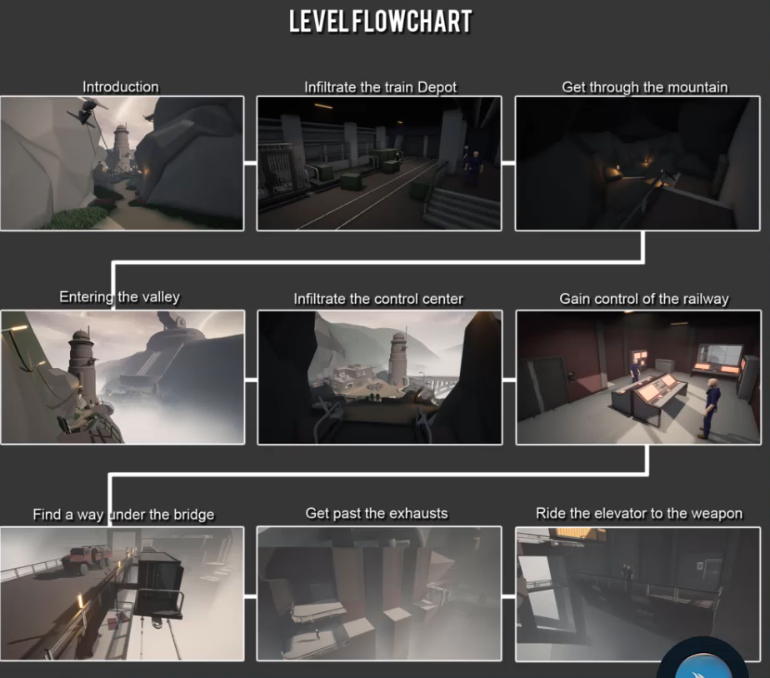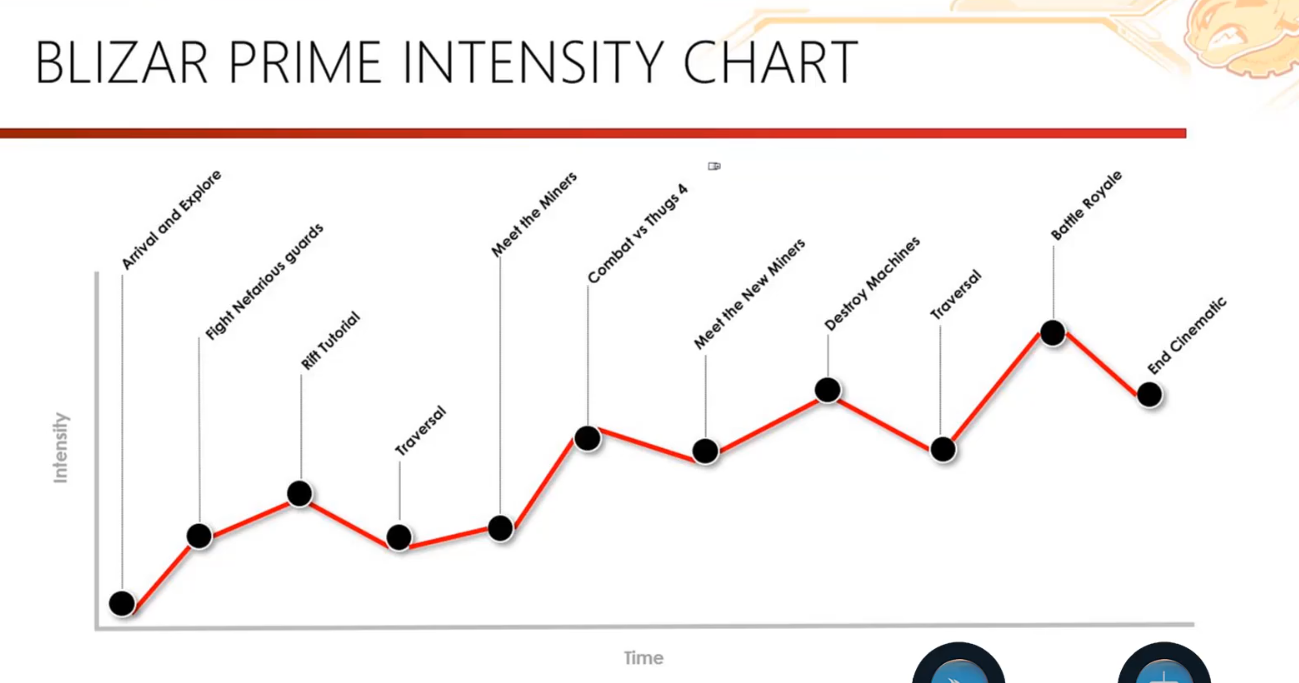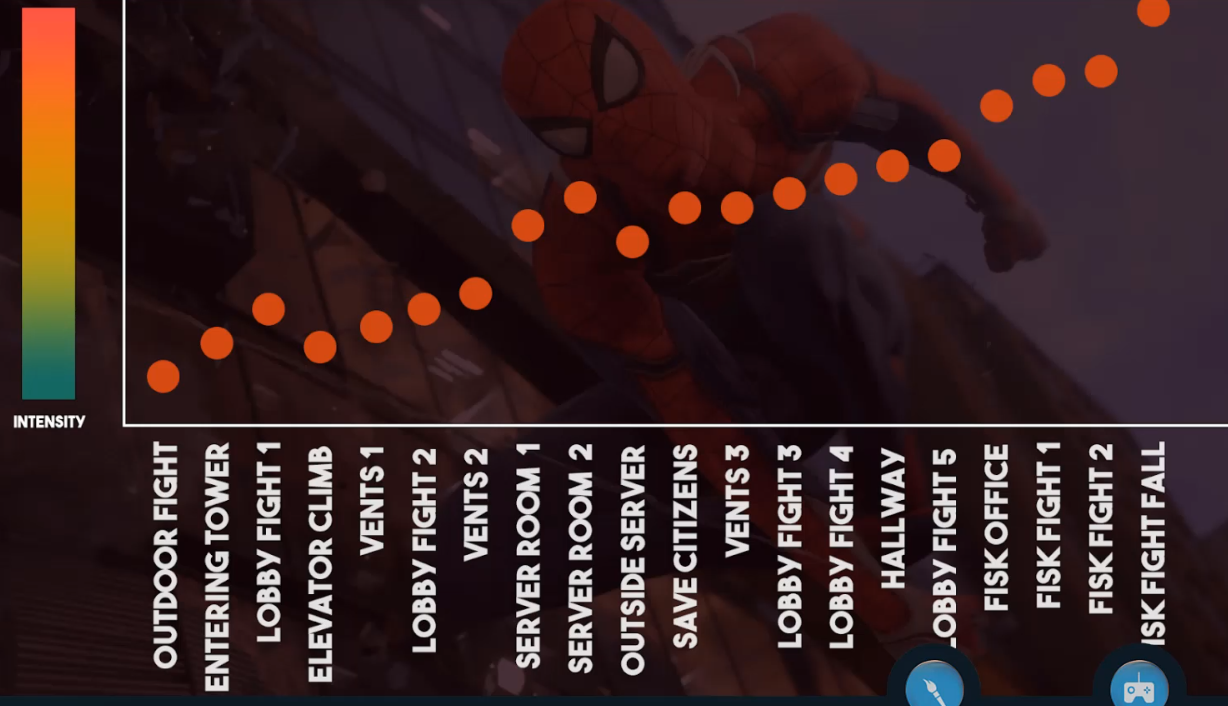Story Missions
A mission should have a clear objective for the player accomplish. Examples:
- Reach a specific location in a survival horror game, the player might have to navigate through a haunted mansion to reach a safe room where important story-related documents are located
- Rescue a character in a platformer game, the player may be required to recue a kidnapped character by navigating through a series of challenging levels, overcoming obstacles and enemies along the way.
- Defeat a boss in a action-adventure game, the player may need to defend a powerful enemy boss who is blocking access to the next area or holding a crucial piece of info
A mission should be grounded in the game’s narrative providing relevant story elements or advancing the plot. It can be connect to the larger story arc and contribute to the player’s understanding of the game world, characters or events. Examples:
- Gathering intel in a spy-themed game, the player might undertake a mission to infiltrate an enemy base and gather crucial information about a villain’s evil plans
- Defending a stronghold in a fantasy RPG, the player might be assigned the mission to defend crucial stronghold from invading forces. This mission would showcase the player’s role in the larger conflict

Beat Breakdown and Tempo
A mission should support the objective and provide a suitable environment for gameplay. It should guide the player towards the objective and create a sense of progression on the long run. She can also enhance the experience by providing a sense of exploration and discovery by presenting hidden secrets, points of interest or even optional objectives. A mission also can present a gameplay challenge for a player overcome. Example:
- Stealth Sequences - Gameplay challenges can require the player to remain undetected while infiltrating enemy territory or avoiding security systems. The mission might include guard patrols, security cameras, or sound-based mechanics that force the player to carefully plan their movements, use distractions and take advantages of the environment to stay hidden.
The flow should be very well-paced balancing moments of tension, exploration and action. The analysis of the player progression and rhythm can be done with charts called Beat Charts. This can help the planning phase on each challenge proposed. Some examples of Beat Charts:






Rewards after Mission Complete
Using the beat charts is possible to plan moments of suspense and tension for the player. An encounter with powerful enemies, have to explore dark environments or even navigating through areas with limited resources or time constraints can enhance the tension for a player. After that, when the mission is complete it should provide meaningful rewards to the player such as unlocking new abilities, story revelations or access to new areas. It may also have consequences or impact the game’s narrative or world state.
⭐ Unique Rewards: The mission can offer a unique and valuable rewards that are specific to the narrative or gameplay context. This could include rare items, exclusive weapons or equipment, or interactions with important non-playable characters that provide unique benefits or opportunities ⭐ Access to new areas: Finishing the mission can grant the player access to new areas or locations within the game world. This can open up opportunities for further exploration, side quests, or additional content that expands the player’s experience and provides a sense of discovery ⭐ Unlocking new abilities: Completing the main line mission can reward the player with new abilities, skills or upgrades, that enhance their gameplay capabilities. These rewards can provide a sense of progression and empower the player to take on new challenges or explore previously inaccessible areas
Balancing Spaces
If players encounters the same type of gameplay over and over they may start feeling bored or disengaged. Its important to mix match gameplay elements. We can also offer optional or alternative approaches to cater to playstyles. For this we should be be carefully sequencing these gameplay elements ensuring they complement each other, you can create a balanced experience. By varying the intensity and pacing of gameplay elements help to maintain player interest. For example, mix moments of high-action combat with slower-paced exploration or puzzle solving sections.
⭐ It’s also essential to leverage the narrative and integrate gameplay elements seamlessly, enhancing the overall cohesion of the mission or quest. Is possible to do it by alternating mechanics, its a level designer job to keep the gameplay engaging while align the narrative.
Dialog
Level designers can help the team by adding placeholders dialogs to the missions establishing the narrative and give a sense of what’s happening in the game. When building levels, we need to consider the spaces to accommodate dialog and allow players to have meaningful conversations or experience narrative moments. The spaces where the player is traversing should provide enough room for characters to interact and allow players to comfortably hear the dialog without feeling rushed or interrupted by gameplay elements.
⭐Through carefully crafted set pieces, environmental cues and atmospheric details, they enhance the dialog and deepen the player’s connection to the game’s world and characters.
The creation of dialogs are collaborative process, and a dedicated story writer may later refine and enhance the lines to ensure they align with the game’s overall narrative vision but an initial draft can be made by the level designer. As we design our levels, we should be open to feedback and interaction from the writing team.
Cutscenes and Cameras
A level designer can create placeholder cutscenes and cameras to establish narrative and cinematic moments. These placeholders should be representations of the final cutscenes and camera angles, so designers can have a better visualization of the flow and pacing.
⭐Cameras and cutscenes are great way to organize your gameplay beats since them can determine some starting and ending of event.
Its possible to experiment with different angles for camera and movements, this allows to define a desired atmosphere, by highlighting important events, POIs or even guiding the player focus. Its a task for the level designer to figure out the impact of the cutscenes on the gameplay and on the stage flow. So early cutscenes can and probably will be implemented by the level designer
Enemies and Combat Planning
There’s many ways that enemies can be placed in a game to players fight. Its common to have the following:
- Spawn Closets: Some kind of enclosure, where the enemies can be spawn outside the player view. Think of an elevator closing, and then the enemies spawn, the elevator open open revealing the enemies and the enemies engage it with the player.
- Layouts: The enemies are placed direct onto the local
- Waves: The player is “trapped” while waves of enemies come to him. A good example of it are the Joker tugs on Batman Arkham Asylum while Batman is inside the arena.
⭐ Remember to get vertical when possible.
Combat Architypes:
It’s important to add variety and surprises within these archetypes to keep the gameplay fresh and exciting for players. They can be combined, modified or expanded upon to suit the specific gameplay mechanics, narrative and artistic vision of the game being designed.
Templates or structures for designing engaging combat serve as starting points for designing combat scenarios and can be adapted and combined to create more complex and engaging encounters. - They provide a framework for level designers to structure the flow, pacing and challenges of combat sequences
-
Ambush Architype: Enemies surprising the player from attacking from hiding position
- Tension
- Quick Reaction
- Sudden Threat
-
Defense Architype: Stop and defend a stop from waves of NPCs
-
High and Lo Advantage: Explore the terrain to give the upper hand to the player or the enemies given it a strategic advantage
-
Stealth Architype: Allowing the players to stealth to eliminate enemies.
-
Boss Battle: Challenging and skill checking if the player can use what they learn to defeat the boss by exploiting the bosses weakness
-
Escort: Protect and NPC traverse a dangerous area
-
Multi-Stage: The battle field change during the battle as the boss IA
Tutorials
A tutorial is designed a game mechanic, control or core concept is introduced to the players. Level designers should allocate dedicated areas where players can learn and practice new mechanics or concepts at their own pace. Its common to create placeholder tutorials to test and iterate, these prototypes should provide a rough representation of the intended experience.
⭐By providing a separate tutorial space, players can focus on learning without the risk of failure or being overwhelmed by other gameplay elements.
If possible, try to integrate the tutorial elements within the gameplay, by using visual cues, environmental storytelling, or non-playable characters to guide and educate players this way they can learn by engaging with the game world. Some examples of tutorials without “words”:
- Place a glowing object near a locked door can indicate that the player needs to find a key to unlock it. The visual cue guides the player without explicitly stating what they need to do.
- Use the environment itself to provide subtle tutorials. For a first person shooter, the first level might include a shooting range where the players can practice their aim and learn to controls before facing real enemies.
Some games also utilize their NPCs to provide some guidance and tutorials by integrating helpful NPCs into the game world, players can learn important gameplay mechanics while interacting with the characters
Valves and Air locks
On bigger games its important that the level designer segment the game to plan a better experience as for allow a seamless load.
Valves:
A design technique that restricts player movement or progress in a certain direction, typically to create a linear narrative experience. The valves help level designers shape the player’s journey, maintain narrative coherence, guide gameplay progression, and enhance the overall game experience by providing structure, direction and moments of tension and reward. They are points of no return where the player can’t backtrack or even go to previous sections. Doing this, the level design guarantee that players move forward and experience the game’s story in the intended order. This techniques is often used to control the pacing and narrative flow of the game. You can also separate gameplay like dropping them into a combat scenario.
⭐ Valves help prevent players to becoming lost or overwhelmed by providing a structured and directed gameplay experience. ⭐Valves can be used to mark significant milestones or checkpoints in the game. Crossing a valve often signifies progress and serves as a reward for the player’s accomplishments
The player may encounter locked doors or barriers that can only be opened by activating valves located elsewhere in the level. Opening these valves grants access to new paths, secrets or rewards. Valves can be incorporated into time-based challenges, where the player needs to reach a specific location before the valve closes. This creates a sense of urgency and tests the player’s speed and agility.
Air Locks
These are transitional spaces or areas where the game loads the next section while the player is still able to play, effectively hiding the loading process. This technique was applied on the first God Of War and was used to create a seamless transition between different areas or levels without interrupting the player’s experience with visible loading screens or significant pauses.
❗ Multiplayer Environments: In multiplayer games, airlocks can be used to synchronize and load new players into a shared game session without interrupting the experience for existing players.
- This ensures that everyone enters the game world at the same time and in a coordinated manner
Cinematics also can be used to hide the loading and transition between open/closed environments. Since the gamedevs can predict the time some are take to load, they can study ways of integrating cutscenes.
Week 07 - Assignment
This week we should focus on create a mission from the horror game. For this week I should focus on try to get more attention from people and try to make a good pitch using more imagery than text.
I tried to keep much more smaller and concise than the other weeks. Got some inspo from Demonologist and Phasmophobia, both games I have more than 30hrs of gameplay. My main focus on this was to think about the Valves and Air Locks that I could be creating through the level. Its veeeeeery straight forward with 2 long corridors, but I think they are necessary and make sense on the contexts. Test as first person, but also test as a third person. I don’t know which one is better on this case. I would love to know your opinion! On the pureref file will be the pitch with the used references
Goals for this week’s assignment included:
- Create a Powerpoint or image gallery describing the pitch of the mission
- Also include a chart in any style showing the intensity and beats
- Design a layout that allows you to create pacing
- Create a goal for the player that will help them beat the level
- Build a level layout that supports the mission’s objectives and narrative.
- Consider the flow of gameplay, the placement of key elements, and the overall progression of the mission.
Link to original


